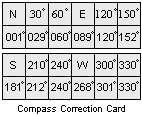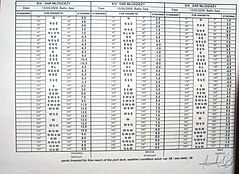Deviation table
Deviations of the magnetic compass are entered in a deviation table (from Latin deviatio , deviation ' ) or also a diversion table for navigation of ships or aircraft . B. caused by metal parts or electrical lines on board.
It is used to be able to carry out course calculations.
Create deviation table
The creation of a deviation table in maritime and aviation are basically the same, but there are some differences due to history and operational requirements. Different terms are also used.
The table is created by comparing the magnetic compass in the ship or aircraft with a reference. To do this, it is rotated 360 degrees in steps of 10 degrees for ships or 30 degrees for aircraft and the deviation of the compass, the deviation , is noted for each of these positions.
The deviation table only shows the deviation of the compass caused by on-board influences. The metal ship or aircraft construction, electromagnetic fields and large metal blocks (engine) are the most common causes of the deviations. The closer they are to the compass, the stronger their disruptive influence. Poor compasses can cause significant deviations in navigation. To avoid bad compasses, these can be compensated for with the help of small correction magnets.
aviation
In the case of compensation, the following can be used as a reference:
- a calibrated bearing compass
- a rotating anti-magnetic target disc with bearing markings
- a previously measured bearing site without magnetic interference with floor markings
- a highly accurate on-board system, e.g. B. Inertial Navigation System (INS), Attitude Heading Reference System (AHRS)
Larger errors (> 10 ° deviation) can be compensated for with the help of small correction magnets or by changing the installation position.
The residual error is documented in the deviation table for the purpose of calculating the course.
Compensation is usually started with one of the main axes: north / south or west / east. Larger deviations are then eliminated in the main axes with the help of the small correction magnets, i. H. There is a setting option for the north-south axis and the west-east axis. If you notice in the first run that there is a larger deviation across both main axes, the installation position can usually be changed slightly.
If the main axes are now subject to a deviation from the reference of less than 10 ° after the compensation, the other directions are checked in steps of 30 °.
Finally, a deviation table or a control table is created from the recorded values.
The actual deviation value is written down in the deviation table, e.g. B. −1 or +2.
Italic text: I'm not entirely sure here.
The nominal value in the deviation table corresponds to the magnetic heading, abbreviation mwSK, English Magnetic Heading - MH or the magnetic heading, abbreviation mwK, English Magnetic Course - MC.
This depends on whether the pilot took the wind into account before considering the deviation.
In connection with the deviation table, the pilot calculates the compass heading, abbr .: KSK, English: Compass Heading - CH.
The term diversion table was also used in older deviation tables. This term was probably adopted from seafaring, but is no longer used in aviation today.
The course that the pilot must fly is specified in a control table. The advantage of the control table is that the pilot saves one calculation step and thus avoids a source of error. The setpoint in the control table also corresponds to the magnetic heading, assuming that the pilot has previously taken the wind into account. The value in the "Steer" line then corresponds to the compass heading, abbr .: KSK
The compass should be checked and, if necessary, compensated:
- after installing / replacing the compass
- if an incorrect display is suspected
- after major modifications
- after a lightning strike
- after an engine change, unless otherwise specified by the manufacturer
- after long idle times
- regularly, due to the corresponding requirements B. by manufacturer or legislator
seafaring

The table is created by rotating the vessel 360 degrees in 10-degree increments at a location with a known bearing and recording the deviation of the compass, the deviation , at each of these positions.
The declination , i.e. H. the deviation of the (time-variable) magnetic north pole from the geographic north pole can be calculated. For this purpose, deviations anchored in the ground or floating deviation buoys are set up in many harbors , from which bearings to fixed landmarks are noted on nautical charts. Seen from above, it is painted two identical black and white fields that are crossed each other.
The resulting deviation table is used to calculate the magnetic course from a course read from the compass . This is then corrected for the magnetic declination, whereby the correct course is obtained. The sum of the deflection and magnetic declination is called the magnetic compass misalignment (MgFw).
Ship compasses can be compensated by means of small bar magnets attached to the housing.
In order to be able to steer or navigate precisely, it is important to subdivide the (course-dependent) deviation table as finely as possible. One differentiates:
- The distraction table: It is used to correct the compass course (MgK) to the magnetic course (mwK).
- The control panel: It is used to generate the magnetic compass course to be steered from the magnetic course. These calculation steps are part of the course conversion .
See also
Individual evidence
- ↑ Announcement on the principles for the designation of German coastal waters , Federal Law Gazette Part II, 1954, No. 2 of February 27, 1954, page 25, Paragraph 6.210.




